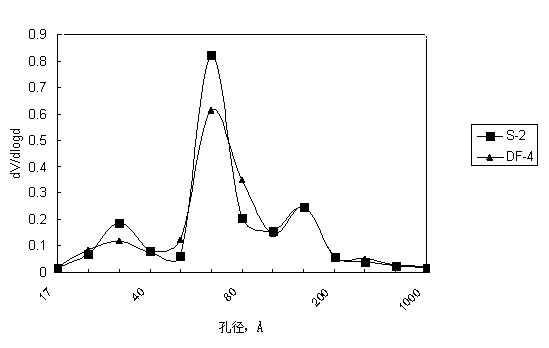Preparation method of catalyst carrier material containing molecular sieve and amorphous silica-alumina
A catalyst carrier, amorphous silica-alumina technology, applied in molecular sieve catalysts, catalyst carriers, chemical instruments and methods, etc., can solve problems such as blockage of molecular sieves, amorphous silica-alumina agglomeration, easy access to each other's channels, etc., to improve performance , avoid agglomeration, enhance the effect of binding force
- Summary
- Abstract
- Description
- Claims
- Application Information
AI Technical Summary
Problems solved by technology
Method used
Image
Examples
Embodiment 1
[0032] Add 366g of solid aluminum chloride into 1.5 liters of distilled water while heating and stirring until dissolved to obtain aluminum chloride solution (a). Add an appropriate amount of distilled water to the concentrated ammonia water and dilute it into about 10% dilute ammonia water (b), and dissolve 70g of xylitol in 500ml of water to form a solution (c). Take 10L of water glass (industrial grade, modulus 3.0) and dilute it in 20L of deionized water to prepare solution (d). Dissolve 20.5g of diethanolamine in 100ml of water, heat to 60°C, add 52g of modified Y-type molecular sieve Y-1 (SiO 2 / Al 2 o 3 The molar ratio is 11.0, the unit cell constant is 24.42 Å, and the relative crystallinity is 95%) beating for 2 hours to obtain slurry (e). Take a stainless steel reaction tank, add (a) into the tank, stir and heat to 65°C, open the valve of the container containing (b), control the system in the tank to drop to pH = 4.5 within 10 minutes, and continue to drop (b), ...
Embodiment 2
[0034] 366g of solid aluminum sulfate was added to 1.5 liters of distilled water while heating and stirring until dissolved to obtain aluminum sulfate solution (a). Dilute the concentrated ammonia water into about 10% dilute ammonia water (b) by adding an appropriate amount of distilled water, and dissolve 55g of adipic acid in 500ml of water to form a solution (c). Take 10L of water glass (industrial grade, modulus 3.0) and dilute it in 20L of deionized water to prepare solution (d). Dissolve 21g of ethanolamine in 100ml of water, heat to 60°C, add 107g of modified Y-type molecular sieve Y-1 (SiO 2 / Al 2 o 3 =11.0, unit cell constant is 24.42 Å, relative crystallinity is 95%) beating for 2 hours to obtain slurry (e). Take a stainless steel reaction tank, add (a) into the tank, stir and heat to 65°C, open the valve of the container containing (b), and control the system in the tank to drop to pH=4.5 within 10 minutes, at this time, add Add in the tank, continue to drop (b)...
Embodiment 3
[0036] 366g of solid aluminum sulfate was added to 1.5 liters of distilled water while heating and stirring until dissolved to obtain aluminum sulfate solution (a). Prepare the solid sodium metaaluminate to a concentration of 20g Al 2 o 3 / l sodium aluminate solution (b). 109 g of 1,4-butanedioic acid was dissolved in 1 L of water to form solution (c). 119g of ethylenediamine was dissolved in 500ml of water, heated to 60°C, and 1189g of modified Y-type molecular sieve Y-1 (SiO 2 / Al 2 o 3 =11.0, the unit cell constant is 24.42 Å, and the relative crystallinity is 95%), and the slurry (d) is obtained after stirring for 2 hours. Take 10L water glass (industrial grade, modulus 3.0) and dilute it in 20L deionized water to prepare solution (e). Take a steel reaction tank, put 2l of deionized water into it, stir and heat it to 65°C, open the valves of the containers containing (a), (b), (c) and (d) at the same time, and control the pH of the system to 8.0 , Control (a) (c) an...
PUM
| Property | Measurement | Unit |
|---|---|---|
| specific surface area | aaaaa | aaaaa |
Abstract
Description
Claims
Application Information
 Login to View More
Login to View More - R&D
- Intellectual Property
- Life Sciences
- Materials
- Tech Scout
- Unparalleled Data Quality
- Higher Quality Content
- 60% Fewer Hallucinations
Browse by: Latest US Patents, China's latest patents, Technical Efficacy Thesaurus, Application Domain, Technology Topic, Popular Technical Reports.
© 2025 PatSnap. All rights reserved.Legal|Privacy policy|Modern Slavery Act Transparency Statement|Sitemap|About US| Contact US: help@patsnap.com

